.png.transform/rendition-xs/image_image%20(1).png)
Queso Casín PDO
Full-fat, mature cheese made from whole, unpasteurized cow's milk. The milk used for producing the protected cheeses comes from cows of the Asturiana de la Montaña o Casina, Asturiana de los Valles and Frisona breeds and crosses between them. The cheese is made by enzymatic coagulation and the semi-hard or hard paste is kneaded.
Tasting notes
The paste is firm, semi-hard to hard, a yellowish color, with no eyes, although it may have small cracks. It is crumbly when cut and has a buttery texture on the palate. It has a homogenous and plastic consistency, with a strong, powerful aroma. The cheese is a dark creamy yellow color with whitish shades. Each producer's own seal is stamped with a die into the top of the cheese.
The flavor depends on the production process, especially on the number of times it is kneaded in the kneading machine: if kneaded heavily, it has a bitter, spicy, strong flavor, an acquired taste for palates unused to it, and with the penetrating, rustic aroma of butter seasoned by time. If the cheese has been kneaded less heavily, the flavor is the same, although less intense. In all cases, it has a strong, full-bodied, persistent, spicy flavor, slightly bitter at the back of the mouth, with a strong aftertaste.
Other notes
It is an irregular discoid-cylindrical shape, with one side bearing floral or geometrical markings and the producer's symbol or name. The cheese can range from 10 to 20 cm / 3.9-7.8 inches in diameter and from 4 to 7 cm / 1.5-2.7 inches in height, weighing between 250 and 1,000 g / 8.8 oz - 2.2 lb.
The rind is virtually non-existent since, after repeated kneading, the cheese matures uniformly and at the same rate inside and out. Its exterior and interior form a compact, bound mass, which is clean, dry or slightly oily.
Production / Processing method
Casín cheese is made from whole, unpasteurized cow's milk. The cows are fed on a diet based on the natural resources of the local area, grazing on pasture practically all year round, supplemented by hay and fresh fodder from the producer’s own farm, The cheese is made by the enzymatic coagulation of milk, triggered by using animal-based rennet or coagulant as well as fermenting agents and calcium chloride in the exact dose required for achieving the curd in the curdling vat. The process is carried out at a temperature of 30-35ºC / 86-95ºF for about 45 minutes, after which the curd is cut with curd knives. The temperature is raised about 2ºC / 35.6ºF and simultaneously, the curds are stirred for at least ten minutes until they form grains the size of hazelnuts. They are then left to rest for a further ten minutes at least.
The curds are then left to drain in cloths or drainers (plastic containers with holes) for several hours to allow the serum to run off. The process continues in the airing room, where the curds are left on cloths at a temperature of 15-20ºC / 59-68ºF for three days or more. They are turned every day until all the serum has drained away. Lactic fermentation also takes place during this time.
Next, the kneading process begins and part of the salt is added. To achieve greater uniformity, the paste is kneaded several times in a machine consisting of two motor-driven rollers that turn in opposite directions. Salt is added during some of the kneading cycles. The cheeses are shaped by hand by forming the curds (known as gorollus) into a cut-off pyramid and they are then stored in an airing chamber for a period of between five days and two weeks at 15-20ºC / 59-68ºF. The cheeses are turned every day. The 'gorollus' can be kneaded in the machine as many times as required for achieving the desired texture for each producer. The more kneading cycles the cheese undergoes, the smoother and more uniform it will be, it will cure better and have a stronger flavor.
The cheese is finally given either a cylinder-discoid or cake shape (the latter is achieved by first making a ball and then flattening each side until it takes on the desired appearance) and the top side is marked with a seal or stamp with the producer's logo. The cheese then returns to the airing chamber for at least two days. The marcu Casín stamp not only identifies the cheese but also enhances its appearance and occupies the entire visible side of the cheese.
The curing or ripening process is completed in the ripening chamber at a temperature of between 8-10ºC / 46.4-50ºF at 80% humidity. The ripening process starts at the moment in which the curds are produced and should last at least two months, counting from the date on which they were made. During this period, the cheeses are turned and cleaned as required, so they acquire their distinctive features. During the ripening process, a series of physical and chemical changes occur, giving the cheese its final organoleptic properties.
Geography / Relief and climate
The area is bordered to the south by the Cantabrian Mountains, reaching a maximum height of 2,000 m / 6,560 ft on the summit of Peña del Viento, and to the north by the lower Sierra del Sueve range, which reaches its maximum height of 1,159 m / 3,802 ft on the summit of Pico Pienzu. The area can be split into three different parts:
1. To the north, the Sierra del Sueve mountains and their foothills.
2. In the middle, the valleys of the rivers Piloña, Nalón and their tributaries, with their water meadows.
3. To the south is the Cantabrian Mountain range, rising sharply from the valleys and with steep slopes, small valleys and large swathes of forest and shrubs.
With the exception of the highest mountains, this area has a warm oceanic climate, with rainfall occurring all year round, and moderate temperature fluctuations. The typically Atlantic climate conditions are affected by the high mountains. Average annual temperatures drop as altitude increases. Temperatures are generally mild, although conditions in the mountains are harsher, with average winter figures on higher ground of around 0ºC / 32ºF. The area enjoys abundant precipitation, spread fairly evenly throughout the year. Precipitation also increases with altitude.
Regulatory Council
Consejo Regulador de la DOP Queso Casín
Polígono de Silvota, Parcela 96
33192 Llanera
Asturias
Tel: (+34) 985 264 200
casin@dopquesocasin.es
www.dopquesocasin.es
Sources:
- Spanish Ministry of Agriculture
Casín cheese has a strong, full-bodied, persistent, spicy flavor, slightly bitter at the back of the mouth, with a strong aftertaste.


- Queso Casín PDO 1
- Queso Casín PDO 2

Llanera (Asturias)
